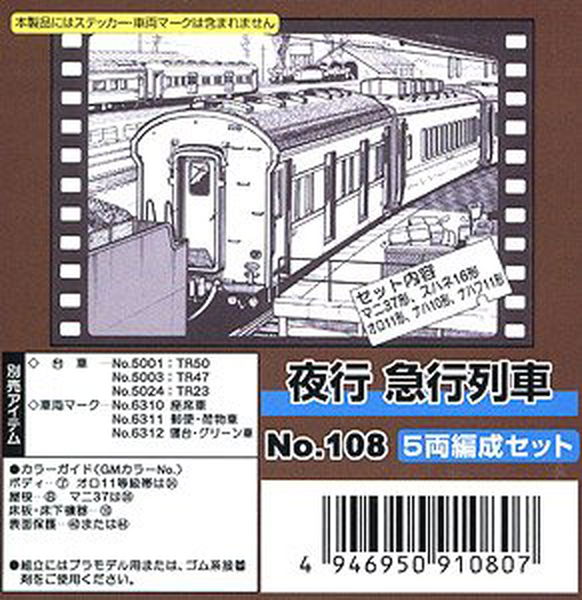J.N.R. Night Express Train Five Car Formation Set (5-Car Unassembled Kit)
[Leader 10 series passenger cars for weight reduction]
-The weight reduction of passenger cars increases the towing capacity of locomotives, leading to speedups, and there are great benefits such as favorable influence on railways, but JNR pays attention to European technology after the war and introduces it to make it lighter I decided to make a passenger car.
-In 1955, the first appearance was the prototype of the third-class sleeper Naha type 10 and the basic seat car Naha 10 that were expected to be active at that time, and the corrugated plate called the keystone plate on the floor plate The oval frame in the underframe is omitted, and the body made up of steel plates up to the roof is integrally welded with a semi-monocoque body. It was a thing.
-In particular, the full-bodied wide body with the inner body sash of Nakane was widely used in the subsequent trains, trains, and passenger cars. Of the four kits in this kit, the Naha 10 is a mass-produced model that has eliminated the folding doors of the deck and replaced it with a normal hinged door. ] Low roof air-cooled version, Suhane 16 is the type after the cooler installation of the second-class sleeper car originally produced as Ohne 17. Only this ohane is a semi-new car that uses the frame of the old model car, and the truck also uses the Suha 43 TR-47, so it is considerably heavier than others.
[A modified luggage car mani 37 with a different taste]
-Luggage Mani 37 type that was downgraded and remodeled (S41-43) from the former special roro, Suro 50, 51, 60, Surofu 53 etc. that became surplus with the progress of trains and was also removed from the air conditioning target, It is a little different from other old luggage cars. The first feature is the floor structure. In order to support pallet transportation, it has a flat floor surface without floor rails, and has a bracket to fix the pallet (loading platform with casters).
-Since it is combined with express trains (especially those in the 200 series can be combined with the latest 14 series. Refer to the instruction manual), all cars are painted blue 15 and this is also different in old luggage vehicles. In addition, in the remodeling group from Sulo 60 of this kit, the wife of one deck from the special era (the conductor's side) is unique to the initial gable passenger car (Suro 60 is Japan's first reclining seat with a reclining seat made shortly after the war, etc. This is a special nickname such as [Mushroom] and [Bread] from passenger car fans.
-In addition, this kit type is unique in that it has both decks added to the opposite side when remodeling the luggage car, and both decks show different expressions. In addition, some Mani 37 were modified from Suha 32 before the war as heresy cars, and this can be reproduced by painting the round roof mani 36 of the GM kit in blue.
[Example of organization]
-Express [Nichinan] No. 3 (1973), Miyakonojo-Miyazaki (→ Osaka)
C57 + Mani 36 (60) + Sukane 16 + Oro 11 + Oro 11 + Naha 10 + Naha 10 + Nahaf 11
-Peculiar operation of Mani 37-200, Express [Nishikai] (1978)
EF58 + Mani 37-200 + and below All 14-seat cars
[Product Contents]
-This set consists of a 5-car train consisting of a 10-series passenger car, which was a pioneer in reducing vehicle weight, and a modified pallet luggage car Mani 37.
-Naha 10 and Nahaf 11 seat cars are mass-produced models that have been replaced with ordinary hinged doors by eliminating the folding doors on the deck.
-Oro 11 is the only [special purpose] low-roof air-conditioning modified car produced as Naro 10.
-Mani 37 of this kit is a modified car from Suro 60, and the deck of the single deck from the special era (the side of the conductor's compartment) is a type that leaves the form unique to the early gable passenger car.
-When remodeling to a luggage car, a new deck is set up on the opposite side to become both decks, and the model is showing a different expression before and after.
-Vehicle mark / sticker included.
* The cart is sold separately.
[set content]
-Mani 37 (Car: TR23) / Oro 11 (Car: TR50) / Shane 16 (Car: TR47) /
-Naha 10 (Car: TR50) / Nahaf 11 (Car: TR50)
[Sold separately]
-Dolly: No.5001 TR50, No.5003 TR47, No.5024 TR23
[Color Guide (GM Railway Color No.)]
-Body: Blue 15 (SP-07)
-Grade 11 grade: Light Green A (SP-34)
-Roof: Silver (SP-08)
-Mani 37 roof: dark gray (SP-35)
-Underfloor equipment: Black (SP-10)
-Surface protection: clear coat gloss (SP-40) or clear coat semi-gloss (SP-44)
* The model will be even better if the aluminum sash window frame is trimmed with silver and H rubber with matte light gray.
[Remarks]
-About painting: Before painting, wash the molded parts thoroughly with a neutral detergent and dry them.













